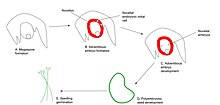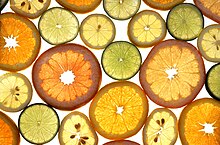Nucellar embryony


Nucellar embryony (notated Nu+) is a form of
Nucellar embryony outside of citrus varieties
Nucellar embryos have also been found in polyembryonic Mango varieties, where generally one of the embryos is zygotic and the rest are nucellar.[5] However, there is little research on Mangos undergoing nucellar embryo development as there has on varieties of citrus.
Conditions
Nucellar embryony is able to occur within both fertilized and unfertilized ovules. Furthermore, instead of using the endosperm as nutritive tissue, it will utilize the surrounding nucellus tissue for nutrition.[3] For example, the ‘Valencia’ orange undergoes nucellar embryony in both fertilized and unfertilized conditions.[3] But, it has been found that nucellar embryo development, under fertilized or unfertilized conditions, can take place in different positions.[6]
Features
An important component of nucellar embryo development is its changing cell wall thickness. Between nucellar embryo's initial cell stage and its dividing and expanding stage, the cells' wall thickens.[7] This most likely occurs due to callose deposition; callose deposition reduces the permeability of a cell and is usually found in the initial cells about to undergo embryogenesis.[8] The initial cells become enlarged, rounded, and divided. During this stage, the initial cell's cell walls thin out, leaving room for the nucleus to become distinguished.
Seedless fruits and influence by the citrus industry
Many seed plants, including citrus fruits, are self-compatible, meaning that they are able to fertilize themselves. Self-compatibility produces a seedy fruit which may be deemed as undesirable to the citrus industry.
Seedless fruits have been made popular as they are sought-after in the citrus industry. To be seedless, a citrus must exhibit self-incompatibility, another reproductive trait within citrus fruits and many seed plants. Self incompatibility is the phenomena where hermaphroditic plants are not able to produce fertile embryos after self-pollination.[9] Self-incompatibility is regulated by the S-loci; if pollen is rendered incompatible, it is determined by its haploid S genotype, or if its sporophyte is rendered incompatible, it would be determined by its diploid S genotype. This is also termed and associated with parthenocarpy, the production of fruit without fertilization. Self-incompatible fruits are able to undergo parthenocarpy to yield seedless fruits. In citrus specifically, there have been other modes developed to reduce seeding as well: gibberellic acid enhances ovule abortion[10] and copper sulfate has been shown to reduce seed number in fruit.[11] An example is the ‘Afourer’ mandarin that contains a haploid self-incompatibility system and parthenocarpy. Under conditions where cross-pollination is not present, the ‘Afourer’ mandarin produces a seedless fruit by undergoing parthenocarpy. Where cross-pollination is present, gibberellic acid is applied and produces a decreased seeding fruit.[11]
Nucellar embryony is important to the citrus industry, as it allows for the production of uniform rootstock which yields consistent results in fruit production. However, this trait can interfere with progress in cross-breeding; most commercial scion varieties produce mainly nucellar seedlings which do not inherit any of the traits of the "father" plant.
See also
References
External links
- Roose, Mikeal L. "Molecular Genetic Analysis of Nucellar Embryony in Citrus" (PDF). Citrus Research Board 2000 Annual Report. Archived from the original (PDF) on 2007-09-30. Retrieved 2006-10-26.
- Kepiro, Joseph L.; Mikeal L. Roose. "Molecular Genetic Analysis of Nucellar Embryony (Apomixis) in Citrus Maximus x Poncirus Trifoliata Using AFLP". Plant & Animal Genomes XI Conference. January 11–15, 2003, Town & Country Convention Center, San Diego, CA. Archived from the original on 2006-10-10. Retrieved 2006-10-26.
